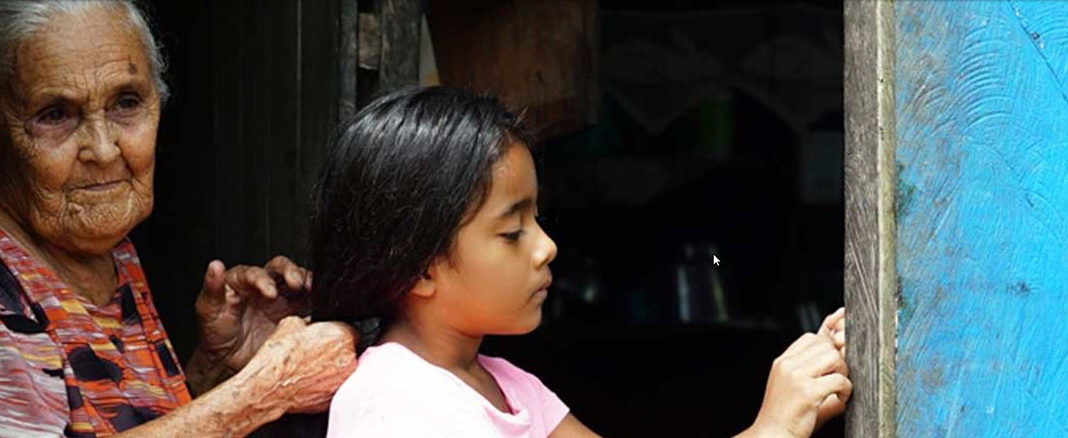- Mineração Rio do Norte (MRN) arrived in the Trombetas River basin in the 1970s with plans to mine bauxite on a gigantic scale. Today, MRN is the fourth largest producer of bauxite in the world, providing the valuable aluminum ore to nations and manufacturers around the planet.
- On arriving in the Amazon, MRN immediately annexed lands from the traditional riverine community of Boa Vista, reportedly displacing 90 families to build its port company town. Boa Vista is a quilombo, a community of Afro-Brazilians (known as quilombolas), the descendants of runaway slaves.
- While MRN says it provided jobs, education and health services, quilombo residents report a decade of horrendous water pollution from mine waste — never cleaned up — the loss of fisheries and hunting grounds, rampant poverty, a lack of electricity, health services, and proper sanitation.
- The harm done by industrial mining to Boa Vista, and lessons learned, and not learned, over the last 40+ years, are especially relevant today, as Brazilian President Jair Bolsonaro aggressively pushes forward his agenda to open indigenous reserves and other Amazon conserved lands to industrial mining.
This story is the first in a series reporting on the legacy, current status and likely future of bauxite mining in the Trombetas river basin and Amazon delta. Journalist Sue Branford and filmmaker Thaís Borges journeyed there in February, 2020. Their investigation of aluminum production is especially relevant now, as Brazil’s Bolsonaro administration pushes hard to open the Amazon’s indigenous reserves and other protected areas to large-scale industrial mining. The original article was published by Mongabay on 4 June 2020. The second article in the series can be found here.
ORIXIMINÁ MUNICIPALITY, Pará state, Brazil — Well before dawn, a loud jarring industrial bang shatters the silence of the Amazon rainforest. Awakened, three-year-old Amanda, heart pounding, races to her grandfather’s hammock.
“She’s always frightened when she hears that racket. After that, no one in the community can get back to sleep,” explains Amarildo de Jesus, coordinator for Boa Vista, a hamlet of just 800 people, mostly Afro-Brazilian, and one of dozens of quilombola communities established in Pará more than 140 years ago by runaway slaves.
The “racket” that so startles Amanda can erupt at any moment, day or night; it happens every time a gigantic transatlantic ore carrier drops anchor in the busy Trombetas River port just half a mile away. The explosive sound is a recurring reminder that the little community’s forest setting is a rural relic of the past, now surrounded on nearly all sides by a highly disruptive and dirty industry.
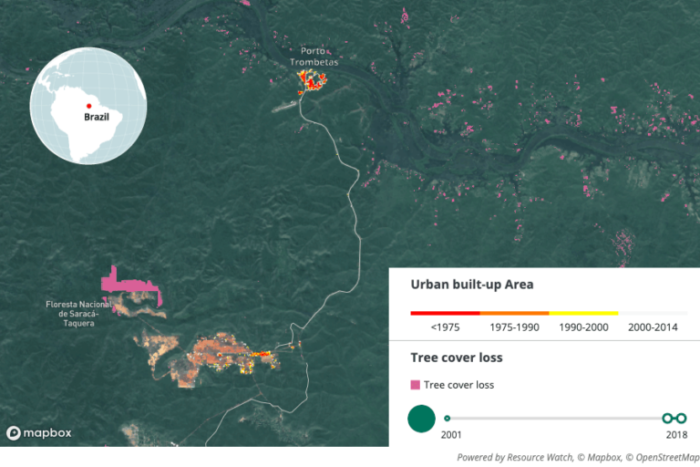
The oceangoing ships are coming up the Amazon and Trombetas rivers to collect ore from Mineração Rio do Norte (MRN), the world’s fourth largest producer of bauxite. That ore is then shipped downriver to processing mills in Barcarena in Pará, or on the Atlantic coast in São Luís in Maranhão state. Some ore is also sent, unprocessed, abroad,
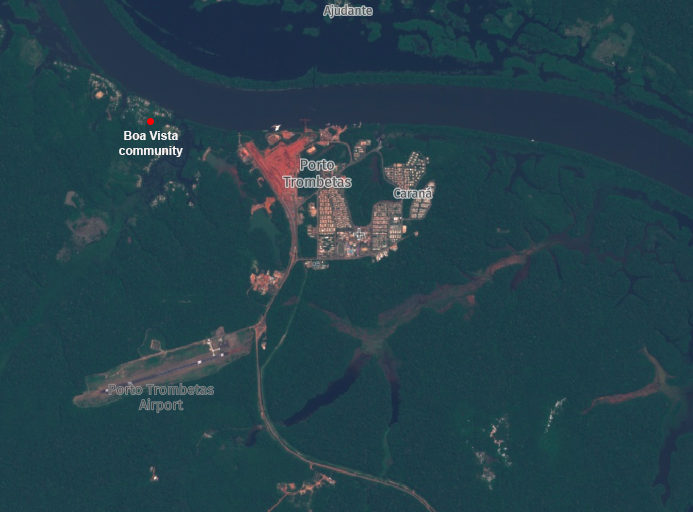
The finished aluminium is then destined for Brazilian manufacturing plants, or factories in the U.S., Canada, China, the EU or elsewhere, where the ubiquitous metal — absolutely vital to the modern world — is shaped into beer and soda cans, or used in computers, mobile phones, planes, cars and other end products.
While MRN officials argue that Boa Vista today is a beneficiary of bauxite mining — the industry does provide jobs — most residents say the social and environmental harms experienced over decades far outweigh the good.
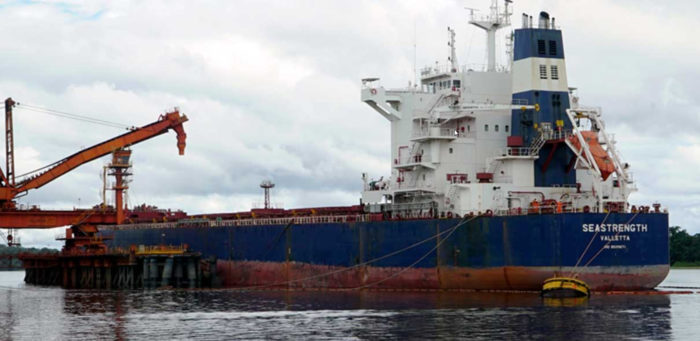
A history of industrial exploitation
Mineração Rio do Norte arrived in the Trombetas basin in the 1970s, and turned tranquil Boa Vista upside down. Like most traditional Amazon riverine communities, it lacked land deeds to prove possession. So MRN annexed much of the community’s land and built the company’s town, known as Porto Trombetas, atop it. Today, the bustling port town has a population of 6,500, mostly employed in bauxite mining and shipping.
“They arrived and tried to buy us off. They [the mining company] said: ‘Take this, and get off this land, as we need it!’” recalls Amarildo. MRN evicted more than 90 families, according to Rosa Acevedo Marin, a lecturer at the Federal University of Pará.
Lacking its communal lands, the little community could no longer grow crops, and all the industrial commotion drove away many of the animals the people used to hunt. The people also lost access to Brazil nut trees, formerly a sustainable cash crop. The intense shipping traffic reduced the fish population in the river and lake waters where they had fished were quickly polluted by mine tailings.
Food security declined steeply. “If we want fruit, we have to buy it. We even have to buy manioc flour [an Amazon staple], because we can’t make it anymore,” says Amarildo.
Today, with those traditional livelihoods destroyed, about 70% of the working age population is directly or indirectly employed by MRN. A few work for the company in management or in the mine. But most are employed by the Boa Vista Cooperative which has a contract with MRN to dole out poorly-paid menial jobs — sweeping, and cleaning and collecting garbage in Porto Trombetas.
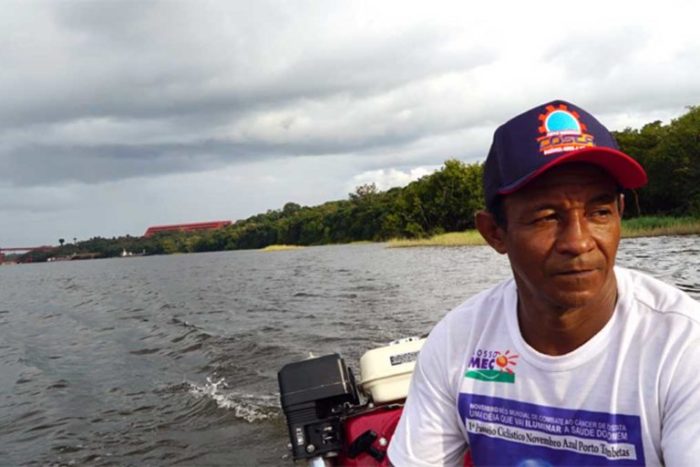
The Coronavirus threat
Life, which has been hard since MRN arrived, is particularly tense now, because of the Coronavirus pandemic. The first three confirmed local cases, detected on 22 April, were an MRN employee and his family. They’d been held in isolation by the company in Porto Trombetas since their return from a holiday in Manaus, the capital of Amazonas state, which has been devastated by the pandemic.
By the end of May, COVID-19 had reached Porto Trombetas on a larger scale, with 96 cases being investigated. The disease, as of that time, was in the “community transmission” stage, with people told to stay at home and only leave in an emergency or to go to work. There have yet been no reported deaths in Porto Trombetas.
“If COVID-19 arrives in Boa Vista, it will be a disaster,” says Lúcia Andrade, the executive coordinator of the Comissão Pró-Índio in São Paulo, an NGO working with quilombola communities since the 1990s. Boa Vista has no basic sanitation and the way quilombolas live, interacting closely with each other, makes it easy for the virus to spread. MRN has said that they will treat Boa Vista residents in their well-equipped hospital but the quilombolas are afraid that, if the pandemic spreads rapidly, the hospital will give priority to MRN employees. It takes six hours in a boat to reach the nearest public hospital in Oriximiná which has only one intensive care bed.
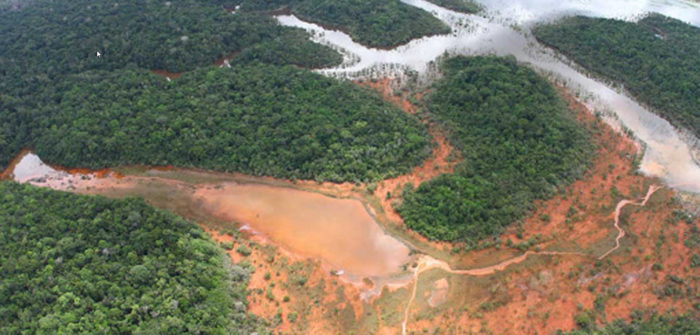
An unequal conflict
Many clashes have erupted over the years between MRN and Boa Vista. But Amarildo recalls with particularly intense emotion the struggle to keep control of Água Fria Creek, which today divides Boa Vista from Porto Trombetas.
“My uncle, Zezinho Ferreira, did a lot to stop the company taking over the creek. He collected tools, like axes and machetes, and got his friends to cut the barbed wire [MRN erected]. He did this countless times [until] finally the company gave up.” During the summer, the creek is still well used by the community for recreation. “When the river water drops, the clean part of the creek is so pretty,” he says.
But the lower stretches of Água Fria are no longer pretty, or usable, smothered by dust first, then by muddy sludge, from the bauxite mine. José dos Santos, one of the community’s oldest residents, remembers putting out pots and pans to dry on a wooden platform after being washed in the creek, only to find them soon covered in a fine red powder blowing in from the mine.
“We suffered a lot from bauxite dust pollution,” he recalls. “When that ended, we got the mud. It came in great floods, flowing into the river, [then into] Água Fria creek, and Batata Lake, which was where we fished.”
Batata Lake today has become a symbol of Amazon ecosystem destruction born of largescale mining projects. “Even though mining companies have been building dams [to hold] waste since the 1950s, the project drawn up by [MRN] the mining company in Oriximiná, arranged for [mine waste] residues to be discharged directly into the rivers and streams,” explained Luiz Jardim, a geographer and lecturer at the Universidade Federal Fluminense in Rio de Janeiro, who has been carrying out research for more than 15 years in the region.
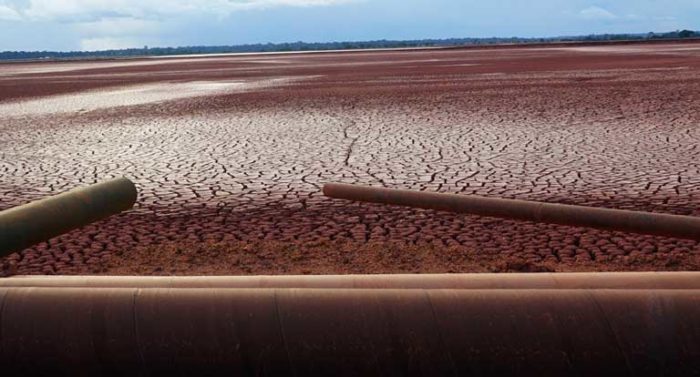
MRN began discharging bauxite tailings into Batata Lake in 1979, eventually blanketing the once pristine fishery with red ooze. The sludge accumulated on the lake bottom as a solid layer several meters thick. It’s calculated that 24 million tons were deposited in Batata Lake over a period of ten years. MRN has tried to clean up the lake but its efforts have not been very successful. Vladimir Moreira, MRN’s Sustainability Director, admits that the lake will never return to its original state, though he hopes further progress will be made. Trace elements found in bauxite — a naturally occurring material — can include poisonous arsenic, beryllium, cadmium, chromium, lead, manganese, mercury, and nickel.
“It’s the biggest industrial disaster ever in Amazônia,” Jardim told Mongabay. “Almost twice the volume of tailings was discharged in Batata Lake compared with the Brumadinho disaster.” It was only in 1989, after international condemnation, that MRN built its first mining waste storage dam and stopped direct discharges into Batata Lake.
“The mining company is accused of carrying out an environmental crime,” says Vladimir Moreira. “I want to be clear that to behave like this today is unacceptable from any point of view. But in the past, it was allowed.” Moreira points out that before 1981 big mining projects in Brazil didn’t require an environmental licence.
Although Lake Batata may appear cleaner today, people living beside it complain of a lack of fish and also suffer from itchy skin and allergies, particularly during the summer, when water levels drop and the red sludge deposits become visible. Animals suffer harm too. “If you’d been here in the summer, you’d have seen caiman and turtles stuck in the mud. They can’t get out and they die,” reveals Isaías Oliveira, a Batata Lake resident.
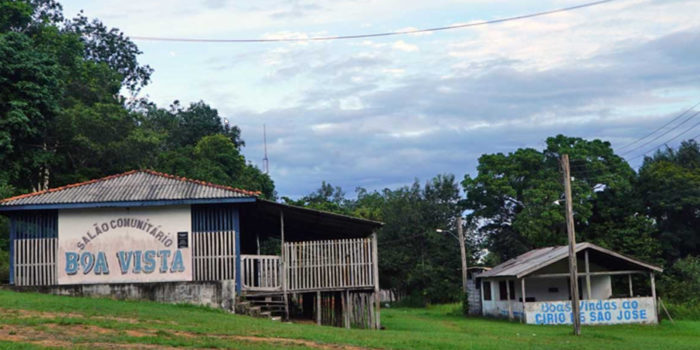
Uneasy peace
In the MRN office, Vladimir Moreira lists the socio-environmental measures taken by the company to mitigate the mine’s impacts. These include income generation schemes and better health and education services. “Perhaps the thing I’m proudest of is the fact that children from the quilombola communities go to the same school as the children of mine employees,” he says. It makes a big beneficial difference, he adds, as the quilombola communities don’t have secondary schools.
But many locals attending the mine’s school are ambivalent. Carlene Printes, now at university in Belém, says her earlier school years were “the most difficult period in my life.” Printes was the target of racist jokes as adolescents whose parents worked for the mine scoffed at the shape of her nose and kinky hair. “What was most painful of all was that the teachers and coordinators made out that I was making a fuss about nothing. Nobody did anything.”
“Today, I wonder if the price we paid for this quality education was too great,” she says. “I don’t know how to fish. I’m 31 years old and, if you gave me a fishing rod, I wouldn’t know what to do with it. I don’t know how to grow vegetables or hunt because the company took all this away from us. And we don’t have enough land to do any of this, in any case.”
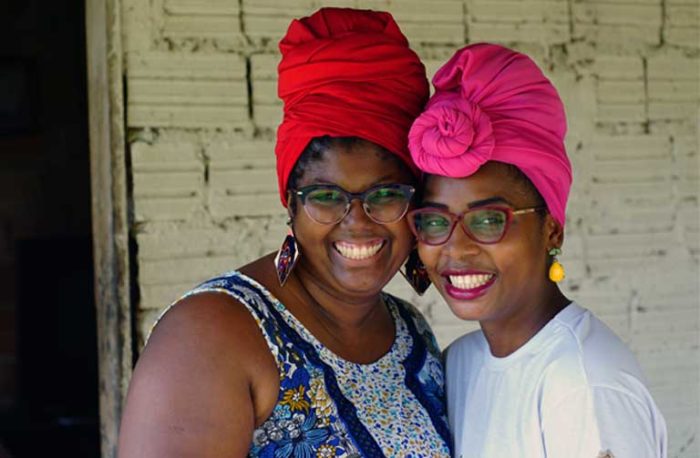
And what of the future?
As many in the community depend today on jobs linked to MRN, the anthropologist Lúcia Andrade, from the Comissão Pro-Índio, is worried about what will happen when the mineral reserves run out. “MRN is [presently] carrying out a series of socio-environmental programs with the [local] population but, until now, I don’t see a consistent discussion or measures that answer this question: what will the future of the community be like when these jobs disappear?”
It may be some time before that happens. According to MRN, existing mines won’t be exhausted until 2025, at which point five more already licensed bauxite sites can take over, producing for two decades; after which other new areas could be opened. Though all of this optimism hinges on a global community hungry for aluminum, demand that could steeply decline if COVID-19 triggers a global economic depression.
Whatever happens, the mining company seems unlikely to have it all its own way. In recent years, local communities have won some rights. For instance, Brazil signed the International Labour Organisation’s Convention 169, which requires “prior, free and informed” consultation with indigenous and traditional communities likely to suffer a major impact from a big new infrastructure project — though Brazil reportedly sidestepped this agreement for the Belo Monte mega-dam and other projects.
Boa Vista was also the first quilombola community in the country to obtain a collective land title, a right established by the progressive 1988 Constitution. Today, five quilombola territories in Oriximiná municipality have won definitive land rights, and others are fighting for recognition. However, many experts are concerned over possible setbacks by the Jair Bolsonaro government.
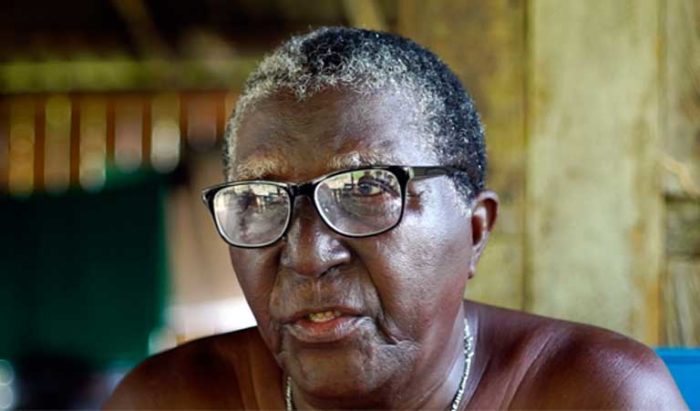
The quilombola story is remarkable: starting in the middle of the 18th century, runaway slaves began settling along the Trombetas River as part of a region-wide movement that was fracturing the slave-based structure in Pará state.
“My grandparents and great-grandparents were slaves,” says José dos Santos. “They fled from plantations in Santarém [an Amazon River port] and came up the Trombetas River to hide.” According to historian Eurípedes Funes, the runaways began to feel safe once they crossed a stretch of river known for its impassable rapids, which acted as a natural barrier to the punitive expeditions sent to recapture them.
Although there were conflicts, former slaves learned to coexist with indigenous groups, the region’s original inhabitants, acquiring from them essential knowledge about living in the forest and utilizing natural wealth to live sustainably.
Even before slavery ended in 1888, the runaways’ descendants began moving downstream to more navigable stretches of the river. Still, life remained far from easy, particularly during the military dictatorship (1964-1985) when the government encouraged mining companies, like MRN, to move in. The quilombos were simply ignored and community lands taken over.
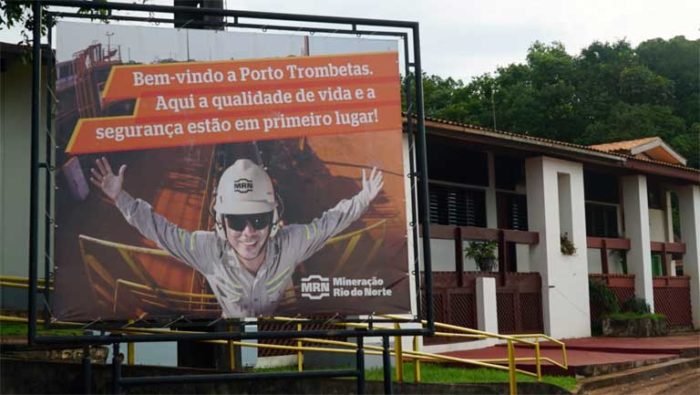
Lapses in energy and sanitation
Today, Porto Trombetas and Boa Vista are two very different worlds. The company town has electric lights, supermarkets, banks, schools that teach English, restaurants, clubs, gyms and an airport. A half mile away, Boa Vista is made up of rough wooden houses often crammed together and built beside dirt tracks; the village lacks basic sanitation. Running water was only installed last year.
Mongabay’s two-hour interview with coordinator dos Santos was frequently interrupted by people complaining of no electricity because the community generator had broken down. “We’ve been suffering for 40 years and they still haven’t bothered to extend the electricity system from Porto Trombetas to here. And it’s so close,” he grumbled.
When questioned about this, mine spokesperson Moreira, said that the community complaints weren’t the mining company’s responsibility, but that of the municipal government. “The real question is: how do we get public powers involved? The mining company isn’t, and shouldn’t be, a substitute for the State,” he said. Mongabay tried repeatedly to talk to Oriximiná’s mayor, but he ignored our requests for comment.
In 2019, the municipality, which has 73,000 inhabitants, received almost R$37 million (US$6.5 million) in Financial Compensation for Mineral Resource Exploitation (CFEM), a tax mining companies pay to federal, state and municipal authorities. Even though Oriximiná has been receiving these payments since 1992, it continues to suffer from a low level of development, according to the last official census in 2010. While the nation had an average per capita income of US$136 then, people in Oriximiná earned an average of just US$56* — less than half Brazil’s average.
Waiting for the much-promised progress that never seems to arrive, Amarildo studies a huge ocean-going ore ship docked at the port, then comments sadly: “This development, we only see it pass by. It only goes to the company.”
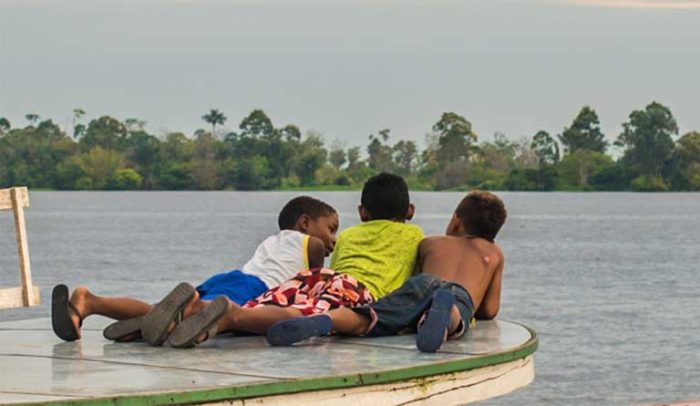
On the verge of tears, he expresses his fears: “I look at my young son and I think, ‘soon I’ll pass on and what will you do with destroyed land and a destroyed river?’ It’s painful for me to see that the Boa Vista community hasn’t a lake where it can fish, nor land where it can hunt, and it’s being invaded on all sides by the company.”
Correction on June 8: *The original story reported in error, using the current 2020 reais / US dollar exchange rate: “While the nation had an average per capita income of US$435 then, people in Oriximiná earned an average of just US$186 — less than half Brazil’s average.” Those figures have now been corrected to reflect the 2010 exchange rate to read: “per capita income of US$136” and “just US$56,” respectively.
Banner image: Local residents who live near once pristine, now heavily polluted, Batata Lake. Image by Thaís Borges.

